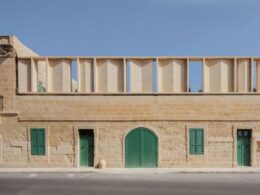The first solo artist to represent Malta at this year’s Venice Art Biennale, Matthew Attard has created a multimedia and interactive installation that focuses on the convergence between vernacular art, cultural heritage and advanced technologies, fitting into a broader reflection on the historical and cultural links Malta has had with the sea and navigation.
The 60th International Art Exhibition of the Venice Biennale, which has just come to a close, is one of the most influential and celebrated cultural events in the world and an important platform for contemporary art and creative expression.
It represents a privileged place for artistic experimentation and each edition is full of new ideas, reflections and challenges, transforming the city of Venice into a creative laboratory on a global level.
For the Malta Pavilion 2024, Attard used technology as a form of contemporary lens to explore and reinterpret historical iconography, making it a memory resistant to the erosion of time.


I Will Follow the Ship represents the culmination of a research process into drawing understood as an act and a sign, crossing the boundaries imposed by this traditional process.
The result is the sign, which, however, Attard arrives at through other unconventional channels, addressing concepts of identity and belonging, with a strong link to his land of origin, Malta.
“We are in the experimentation field between art and technology through research into historical signs reinterpreted using a visual language that seeks to stimulate public reflection and interaction,” the artist said.
His research analyses, documents and reinterprets the naval ex-voto graffiti engraved into the stone of ancient rock chapels. In particular, Attard analyses those identified in Malta – grooves that narrate stories of faith or gratitude towards the unknown.
Images of travel, migration and deep connections with the sea are themes that have particular relevance for Malta, an island at the crossroads of cultures and peoples, with a strong bond with the Mediterranean.
Sailing and the sea are powerful metaphors that Attard uses to express the search for belonging, collective identity and historical memory.

The multimedia installation of the Malta Pavilion, commissioned by the Arts Council Malta and co-curated by Elyse Tonna and Sara Dolfi Agostini, is the result of a reading and reinterpretation of these vernacular testimonies, using eye-tracking, biometric ocular monitoring technology.
Attard has further elaborated the data obtained by converting it into a graphic sign.
The eye-tracker is worn like a pair of glasses and used to monitor ocular movement and understand where, what and for how long a visual input is observed.
The artist’s eye observes the groove dug into the stone, the eye-tracker records his ocular movement and returns it through a series of data, which is processed and combined, through algorithms, into a plot of lines that generate the final drawing.
The eye-tracker takes over the artist’s point of view, analyses its dynamics, when it hesitates and starts moving again, giving back a new perspective.

The installation at the Arsenal of Venice features two scenic wings that welcome visitors, who find themselves inside a game of references between the past and its reinterpretation.
On one side is the reinterpretation of a historical wall bearing the signs of ships, and on the other is a digital wall as a data set. This acts together with other algorithms, constantly generating new images and drawings of moving ships.
The immersive videos are accompanied by the artist’s drawings, and the activation of a QR code allows everyone to model their own interactive boat.
Anna Gallo is an Italian architect, specialised in contemporary art curatorial studies.










